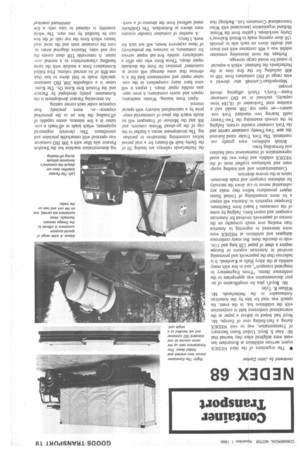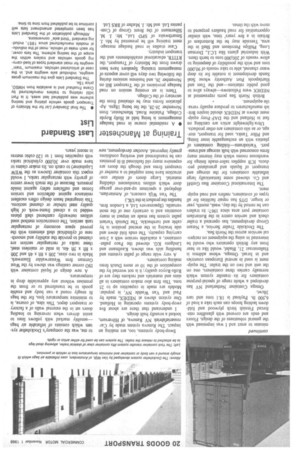NEDEX 68
Page 21

Page 22

If you've noticed an error in this article please click here to report it so we can fix it.
reviewed by John Darker
• The organizers of the third NEDEX export services exhibition at Rotterdam last week were delighted when they learned that Mr. Alan S. Boyd, United States Secretary of Transportation, was to visit NEDEX during a fact-finding tour of Europe. Mr. Boyd had hoped to deliver a paper at the international conference held in conjunction with the exhibition but, in the event, his speech was read for him by the American Ambassador to the Netherlands, Mr. William R. Tyler.
Mr. Boyd's plea for simplification of export documentation was appropriate to the conference theme, "From fragmentary to integrated transport", and in line with many exhibits at the Ahoy Hails at Katshoek. It is ludicrous that the paperwork and processing involved in American exports to Europe require a sheet of paper 1211 long and I lin. wide to describe them. But many conference delegates and exhibitors at NEDEX were more interested in exporting to America than wasting over much sympathy on the morass of paperwork involved for American transport and export firms. Judging by some of the comments I heard from Dutchmen, European exporters to America will expect a lot more streamlining of United States import procedures before they make any substantial moves to cut down the necessity for elaborate transport and trade documentation in the reverse direction.
Containerization and unit-loading equipment and techniques typified most of the NEDEX exhibits and there was the usual representation of international road hauliers and forwarding firms.
British exhibitors were greatly outnumbered. The York Trailer stand featured the new Two-Twenty container carrier and the York container transfer system. Judging by the crowds examining the Two-Twenty outfit bearing two standard York containers—an open top 20ft model and a stainless steel Tanktainer of 18,184 litres capacity, enclosed in an ISO container frame—York's Dutch offspring should prosper.
Metropolitan-Cammell also showed a wide range of ISO containers from 10ft to 4011 including for the first time in the Netherlands the Saltaincr, which is especially suited for mixed cargo stowage.
Perhaps the most interesting container exhibit was a 4011 container with end doors and double doors on each side to provide 15ft door opening made in British Railway's Derby workshops. I gather from the Winnic Holland organization (associated with Winn International Containers Ltd., Barking) that the Netherlands railways are leasing 50 of the Derby-built 40-footers for a trial period before committing themselves to purchasing. The development seems a feather in the cap of the go-ahead Winnic concern, and BR and the Minister of Transport will no doubt watch this piece of commercial enterprise by a nationalized industry with special interest.
Apart from leasing, Winnic maintains, repairs and stores containers; it even operates mobile repair shops. I expect, it will soon have many competitors in the container repair and maintenance field for it is obvious that some damage will occur at customers' premises far from the dockside repair shops. Those firms who can offer a satisfactory mobile first-aid repair service for containers, to increase the productivity of these expensive boxes, will not lack for work, I fancy.
A number of container transfer systems were shown at Rotterdam. The Goldhofer stand suffered from the absence of a work ing demonstration machine but the Swedish Parator side lifter with a 2011 ISO container was operated with remarkable precision and smoothness. This cleverely engineered equipment, which loads or off-loads a container in a few minutes, seems capable of off-loading the box on to the proverbial sixpence—or, more precisely, four sixpences under each corner casting.
An interesting Parator development is the Konetainer, jointly developed by Parator and the Finnish firm Kone Oy. The KonetaMer is a collapsible 2011 ISO container specially made to fold down to less than one-fifth of its erected volume. Five folded Konetainers form a module with the same handling characteristics as a normal container. A removable TIR sheet covers the top and sides. Massive diagonal struts secure the container ends and the stout steel beams which form the top rails of the box can be handled by two men. The whole assembly is claimed to take only a few minutes to erect and I was impressed with the general robustness of the design. Floors and ends are covered with glassfibre reinforced Finnish birch plywood and folddown lashing hoops can each take a load of 6,500 lb. Payload is 18.1 tons and tare 38cwt.
Omega Container Netherland NV has developed a whole range of special-purpose containers for its transfer system which normally carries three containers, one on the unit and two on the trailer. The equipment is used in several European countries and in Israel. Omega, whose address is Hallenstraat 21, Blade], would like to hear from any British operators who would be interested in using the equipment on reciprocal services across the North Sea.
The Dockside Trailer Service, a Netam Group development, has operated a trailer check and service centre in the Rotterdam container port area since 1967: its trailers can be rented by the day, week, month, year or longer. DTS has repair facilities for all types of containers, reefers and road equipment.
The International Container Ban GmbH and Co. showed some fantastically large inflatable containers for the storage and transport of liquids and granulated products. ICH supplies tailor-made linings for warehouse rooms which may interest many firms concerned with bulk storage and transport. Variodrums—folding containers of plastics with an exchangeable inner lining, and Pillor Tanks, used for transport, storage, or as silo containers are other products.
Ultra-lightweight attics are catching on fast in Holland and the DAF-Pony equipment shown at NEDEX should inspire British manufacturers to produce equally versatile equipment.
British North Sea ports represented at NEDEX were Felixstowe—always alive to good public relations—and the Tees and Hartlepools Port Authority whose Seal Sands development is notable for its deep water channel, able to take vessels of 90,000 tons and with the possibility of deepening to allow vessels of 200,000 tons to berth there. With industrial giants like 1.C.I., Dorman Long, Phillips Petroleum and Shell in the area, Teesside may be the Rotterdam of Britain in a few years' time, with similar opportunities for road hauliers prepared to move with the times. Swop-body systems, too, are making an impact. The Renova system made by Carrosseriefabriek NV Renova, of Hilversum, looked a soundly built design.
I understand that there are about five swop-body systems operating in Holland. One system shown at NEDEX, made by Paul and Van Weelde NV, is popular. Models are made in capacities up to 25 tons. This firm also makes containers in all sizes and materials and reckons they are of Rolls-Royce quality; it is not worried by the competition of the 10 or more Dutch firms making containers.
A very wide range of pallet systems and handling aids was shown. Kaufmann and Lindgens KG. showed the Paco palletcontainer, a stackable version with a 2-ton carrying capacity. The ends fold down and side bracing in the erected position is by cable and turnbuckle. The Danish Variant pallet system has made an impact in many countries and is certainly one of the most versatile. (Spacesavers Ltd, a London firm, handles the product in the UK.) The Van Wijk concern, of Amsterdam, displayed a specimen up-and-over garage door which utilizes transluscent cladding material. Large doors of similar construction have been supplied to a number of transport firms and though the doors are expensive many old fashioned ill-lit premises can be transformed and working conditions greatly improved. Another development, new to me, was the company's Dockshelter system which consists of inflatable air bags —sensibly marked with yellows lines to assist drivers when reversing to loading doors set in the external walls of a factory or transport depot. This idea, of course, is to minimize temperature loss, for the bags fit snugly round a van body and enable goods to be transferred to or from the premises without any appreciable drop in temperature.
A new design of liquid container with ISO corner castings was shown by the West German firm Westerwalder Eisenwerk. Made in two sizes, 20ft x 8ft x 4ft and 20ft x 8ft x 5ft 4in. in mild or stainless steel, these tanks of rectangular section are claimed to provide the stability and smoothness of cylindrical shell elements with the proved space economy of rectangular tank section. The construction method used utilizes outwardly cambered shell plates welded to a closed frame-work of high quality steel tubular or channel sections. This integrated beam design offers excellent resistance against deflection and torsion forces and sufficient safety against inside pressure. Because of the much lower centre of gravity with rectangular tanks, I would expect this container (known as the WEW Liquitairter) to catch on. Its maker claims to have made over 30,000 cylindrical tanks with capacities from I to 120 cubic metres in recent years.




































































































